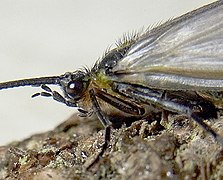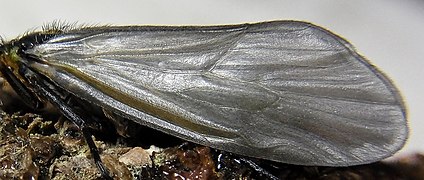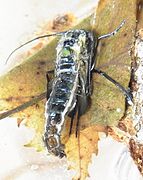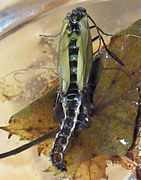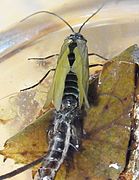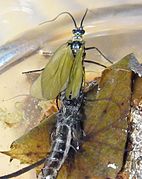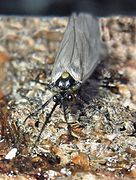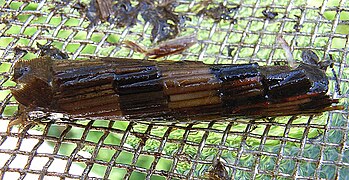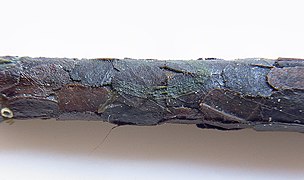Oligotricha striata
| Oligotricha striata | ||||||||||
|---|---|---|---|---|---|---|---|---|---|---|
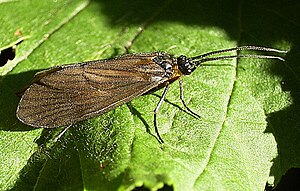
Oligotricha striata |
||||||||||
| Systematics | ||||||||||
|
||||||||||
| Scientific name | ||||||||||
| Oligotricha striata | ||||||||||
| ( Linnaeus , 1758) |
Oligotricha striata is a widespread caddis fly from the Phryganeidae family .
Adult
The head has two laterally protruding compound eyes and three point eyes on the top (Fig. 6). The multi-parted, more than body-long, thread-shaped antennae arise above the eyes . The jaw probes are four-part (Fig. 2). The lower lip can be turned out and is used to lick up the food, the upper jaw has receded, the lower jaw has grown together with the lower lip.
The four wings are milky after hatching (Fig. 2 and 6), later they turn black-brown. The veins are clearly visible (Fig. 3). In the male, the fore wings are 23 mm long, in the female they reach 26 millimeters. At rest they are laid together like a roof and completely cover the smaller longitudinally folded rear wings. The tarsi are five-part. The rails of the front legs have two spurs, those of the middle and rear legs have four spurs each.
Larva and quiver
The head axis of the larva forms an obtuse angle to the body axis (Fig. 3). The head segment and the chest segments are clearly longitudinally striped (Fig. 7). The larva lives in a quiver, which is made up of elements of roughly equal thickness and length, arranged in a spiral. The larva uses existing building material, often pieces of grass, pondweed or characeae , but also pieces of rotted leaf that have been gnawed into shape (compare Fig. 7 top and bottom right). The quiver forms up to 15 turns and reaches a length of up to four centimeters. The quiver is not curved and is open at the back.
development
The larva lives predatory on aquatic insects or frog spawn , the adult animal sucks flower nectar .
The pupa (Fig. 5) suddenly emerges from the water and the Imago hatches immediately (series Fig. 4). After a few minutes it is ready to fly. If it is disturbed beforehand, it runs quickly and fluttering across the surface of the water. The wings are initially milky white and then turn brown.
Habitat and distribution area
The species is distributed all over Europe - with the exception of the Iberian Peninsula . To the east, the distribution area extends to northwest and eastern Russia . In Central Europe, the larvae can be found in small standing and slowly flowing acidic waters, for example in bog lakes or drainage ditches and in high alpine ponds up to 2000 m altitude. The adults appear from March to July.
literature
- Johann Waringer, Wolfgang Graf: Atlas of the Austrian caddis fly larvae. Facultas Universitätsverlag, Vienna 1997, ISBN 3850764117 .
- Wolfgang Engelhardt: What lives in pools, brooks and ponds. Kosmos Naturführer, Francksche Verlagshandlung, Stuttgart 1955.
- Jean Baptiste Pierre Antoine de Monet de Lamarck: Histoire naturelle des animaux sans vertèbres. Verdière 1818.
Web links
- English page about Oligotricha striata with habitat pictures
- English page on Oligotricha striata with microphotos
- Website Trichoptera
- Website Trichoptera
Individual evidence
- ↑ Oligotricha striata in Fauna Europaea. Retrieved March 18, 2011

